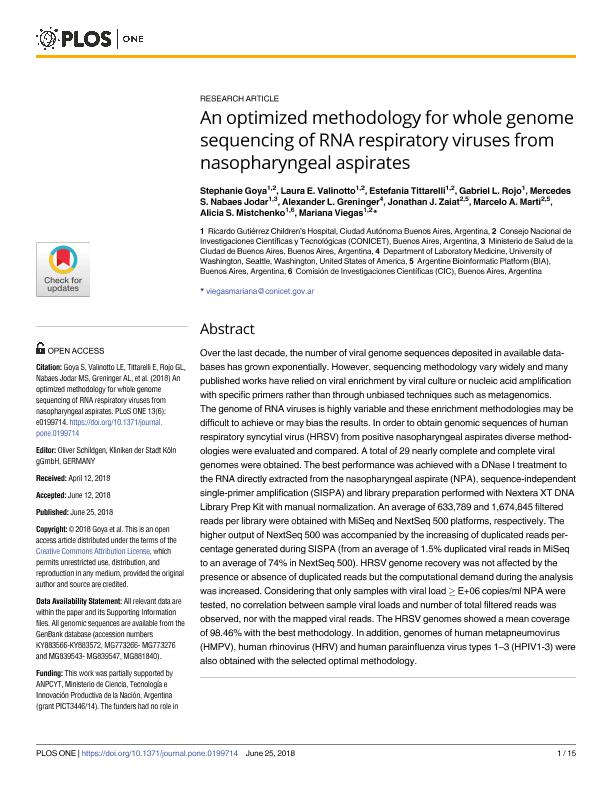Mostrar el registro sencillo del ítem
dc.contributor.author
Goya, Stephanie

dc.contributor.author
Valinotto, Laura Elena

dc.contributor.author
Tittarelli, Estefanía

dc.contributor.author
Rojo, Gabriel Lihue

dc.contributor.author
Nabaes Jodar, Mercedes Soledad

dc.contributor.author
Greninger, Alexander L.
dc.contributor.author
Zaiat, Jonathan Javier

dc.contributor.author
Marti, Marcelo Adrian

dc.contributor.author
Mistchenko, Alicia Susana

dc.contributor.author
Viegas, Mariana

dc.date.available
2020-02-07T23:07:39Z
dc.date.issued
2018-06
dc.identifier.citation
Goya, Stephanie; Valinotto, Laura Elena; Tittarelli, Estefanía; Rojo, Gabriel Lihue; Nabaes Jodar, Mercedes Soledad; et al.; An optimized methodology for whole genome sequencing of RNA respiratory viruses from nasopharyngeal aspirates; Public Library of Science; Plos One; 13; 6; 6-2018; 1-15
dc.identifier.issn
1932-6203
dc.identifier.uri
http://hdl.handle.net/11336/97005
dc.description.abstract
Over the last decade, the number of viral genome sequences deposited in available databases has grown exponentially. However, sequencing methodology vary widely and many published works have relied on viral enrichment by viral culture or nucleic acid amplification with specific primers rather than through unbiased techniques such as metagenomics. The genome of RNA viruses is highly variable and these enrichment methodologies may be difficult to achieve or may bias the results. In order to obtain genomic sequences of human respiratory syncytial virus (HRSV) from positive nasopharyngeal aspirates diverse methodologies were evaluated and compared. A total of 29 nearly complete and complete viral genomes were obtained. The best performance was achieved with a DNase I treatment to the RNA directly extracted from the nasopharyngeal aspirate (NPA), sequence-independent single-primer amplification (SISPA) and library preparation performed with Nextera XT DNA Library Prep Kit with manual normalization. An average of 633,789 and 1,674,845 filtered reads per library were obtained with MiSeq and NextSeq 500 platforms, respectively. The higher output of NextSeq 500 was accompanied by the increasing of duplicated reads percentage generated during SISPA (from an average of 1.5% duplicated viral reads in MiSeq to an average of 74% in NextSeq 500). HRSV genome recovery was not affected by the presence or absence of duplicated reads but the computational demand during the analysis was increased. Considering that only samples with viral load E+06 copies/ml NPA were tested, no correlation between sample viral loads and number of total filtered reads was observed, nor with the mapped viral reads. The HRSV genomes showed a mean coverage of 98.46% with the best methodology. In addition, genomes of human metapneumovirus (HMPV), human rhinovirus (HRV) and human parainfluenza virus types 1–3 (HPIV1-3) were also obtained with the selected optimal methodology.
dc.format
application/pdf
dc.language.iso
eng
dc.publisher
Public Library of Science

dc.rights
info:eu-repo/semantics/openAccess
dc.rights.uri
https://creativecommons.org/licenses/by/2.5/ar/
dc.subject
Respiratory viruses
dc.subject
NGS
dc.subject
Respiratory syncytial virus
dc.subject
Viral complete genomes
dc.subject.classification
Virología

dc.subject.classification
Ciencias Biológicas

dc.subject.classification
CIENCIAS NATURALES Y EXACTAS

dc.title
An optimized methodology for whole genome sequencing of RNA respiratory viruses from nasopharyngeal aspirates
dc.type
info:eu-repo/semantics/article
dc.type
info:ar-repo/semantics/artículo
dc.type
info:eu-repo/semantics/publishedVersion
dc.date.updated
2019-10-24T19:09:42Z
dc.journal.volume
13
dc.journal.number
6
dc.journal.pagination
1-15
dc.journal.pais
Estados Unidos

dc.journal.ciudad
San Francisco
dc.description.fil
Fil: Goya, Stephanie. Gobierno de la Ciudad de Buenos Aires. Hospital General de Niños "Ricardo Gutiérrez"; Argentina. Consejo Nacional de Investigaciones Científicas y Técnicas; Argentina
dc.description.fil
Fil: Valinotto, Laura Elena. Gobierno de la Ciudad de Buenos Aires. Hospital General de Niños "Ricardo Gutiérrez"; Argentina. Consejo Nacional de Investigaciones Científicas y Técnicas; Argentina
dc.description.fil
Fil: Tittarelli, Estefanía. Gobierno de la Ciudad de Buenos Aires. Hospital General de Niños "Ricardo Gutiérrez"; Argentina. Consejo Nacional de Investigaciones Científicas y Técnicas; Argentina
dc.description.fil
Fil: Rojo, Gabriel Lihue. Consejo Nacional de Investigaciones Científicas y Técnicas; Argentina. Gobierno de la Ciudad de Buenos Aires. Hospital General de Niños "Ricardo Gutiérrez"; Argentina
dc.description.fil
Fil: Nabaes Jodar, Mercedes Soledad. Gobierno de la Ciudad de Buenos Aires. Hospital General de Niños "Ricardo Gutiérrez"; Argentina. Consejo Nacional de Investigaciones Científicas y Técnicas; Argentina
dc.description.fil
Fil: Greninger, Alexander L.. University of Washington; Estados Unidos
dc.description.fil
Fil: Zaiat, Jonathan Javier. Consejo Nacional de Investigaciones Científicas y Técnicas; Argentina
dc.description.fil
Fil: Marti, Marcelo Adrian. Consejo Nacional de Investigaciones Científicas y Técnicas; Argentina
dc.description.fil
Fil: Mistchenko, Alicia Susana. Gobierno de la Ciudad de Buenos Aires. Hospital General de Niños "Ricardo Gutiérrez"; Argentina. Provincia de Buenos Aires. Gobernación. Comisión de Investigaciones Científicas; Argentina
dc.description.fil
Fil: Viegas, Mariana. Consejo Nacional de Investigaciones Científicas y Técnicas; Argentina. Gobierno de la Ciudad de Buenos Aires. Hospital General de Niños "Ricardo Gutiérrez"; Argentina
dc.journal.title
Plos One

dc.relation.alternativeid
info:eu-repo/semantics/altIdentifier/doi/https://doi.org/10.1371/journal.pone.0199714
dc.relation.alternativeid
info:eu-repo/semantics/altIdentifier/url/https://journals.plos.org/plosone/article?id=10.1371/journal.pone.0199714
Archivos asociados
